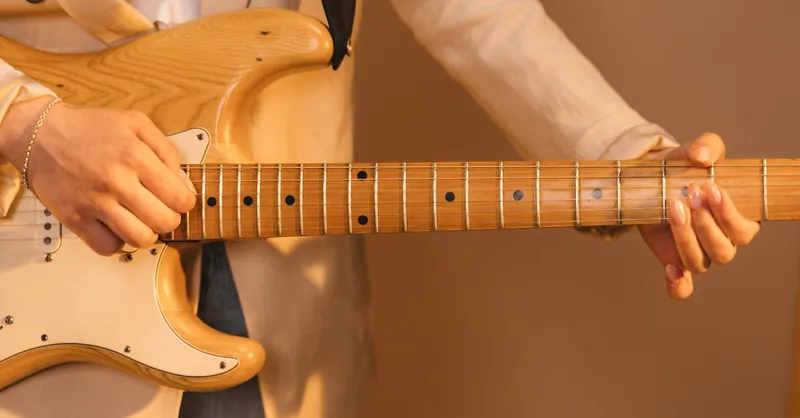Beginner Tips for Playing Melody on Guitar Easily
Category: Music Theory
Unlock Your Guitar Melody Skills with Ease
Starting to play melodies on the guitar can feel intimidating when you’re a beginner musician. You've probably practiced chords and rhythm but find it challenging to smoothly play single-note melodies or figure out how to make your soloing more musical. Maybe you've searched the web for beginner tips and tutorials but got overwhelmed with complex music theory or technical jargon that just doesn’t click. This guide is crafted precisely for you – someone passionate about guitar who wants clear, digestible guidance on playing melody effortlessly, blending theory and practical steps that make sense. We’ll break down the essential concepts you need, focusing on approachable techniques that set you up for success without confusing theory overload. Alongside guitar, if you also play piano or are curious about how melody works across instruments, you’ll find easy-to-understand parallels that expand your musical foundation. This post stands out by merging beginner-level music theory with actionable guitar tutorials, helping you move from uncertain to confident note player. Ready to unlock your melodic potential and enjoy playing memorable tunes? Let’s dive into these beginner tips and build your melody skills step-by-step!
- Unlock Your Guitar Melody Skills with Ease
- Understanding What a Melody Is and Why It Matters on Guitar
- Familiarizing Yourself with the Guitar Neck for Melody Playing
- Essential Music Theory Concepts for Guitar Melodies
- Learning Simple Scales and Their Role in Melodies
- Techniques to Play Clean and Expressive Melodies
- Developing Your Ear for Melodies: Basic Ear Training Tips for Guitarists
- Practicing with Easy Melodic Songs and Exercises
- Understanding Phrasing and Dynamics in Guitar Melodies
- Integrating Music Theory with Practical Playing: Enhancing Improvisation and Composition on Guitar
- Transitioning from Guitar to Piano: How Melody Concepts Cross Over
Understanding What a Melody Is and Why It Matters on Guitar
At its core, a melody is a sequence of single notes that sounds musically satisfying and expresses a musical idea. Unlike chords, which are multiple notes played together to create harmony, or rhythm, which deals with the timing and beat, melody focuses on the horizontal flow of notes—like a musical story unfolding one note at a time. On the guitar, playing melodies means moving beyond strumming chords to picking out clear, distinct notes that carry the tune.
Why does melody matter so much for guitarists? Because mastering melody unlocks the true expressive potential of your instrument. Whether you’re playing a recognizable song’s main tune, improvising a solo, or creating your own musical ideas, understanding melody allows you to communicate emotion and build memorable phrases. It shapes the listener’s experience by giving music direction and personality. For beginners, this foundation transforms your playing from just rhythm support or chord backing into something melodic and engaging—making your guitar sing in its own unique voice. This focus on melody also bridges your learning from basic chords into more advanced techniques like lead playing, phrasing, and musical storytelling.

Image courtesy of Nathan Martins
Familiarizing Yourself with the Guitar Neck for Melody Playing
One of the most important steps to confidently playing melodies on guitar is knowing the layout of notes on the fretboard, especially within the first five frets. This area is where beginners often start because it’s easier to navigate and it covers many common notes used in popular melodies and scales. By understanding how notes are arranged across strings and frets, you’ll quickly recognize patterns and shapes that unlock melodic possibilities without needing to memorize every single note individually.
The Note Layout on the First Five Frets
The guitar’s standard tuning, from lowest (6th) string to highest (1st), is E–A–D–G–B–E. Each fret raises the pitch by one semitone, moving chromatically up the scale. Here’s a quick overview of notes you’ll find on the first five frets of each string:
| String | Open String | 1st Fret | 2nd Fret | 3rd Fret | 4th Fret | 5th Fret |
|---|---|---|---|---|---|---|
| 6th | E | F | F♯/G♭ | G | G♯/A♭ | A |
| 5th | A | A♯/B♭ | B | C | C♯/D♭ | D |
| 4th | D | D♯/E♭ | E | F | F♯/G♭ | G |
| 3rd | G | G♯/A♭ | A | A♯/B♭ | B | C |
| 2nd | B | C | C♯/D♭ | D | D♯/E♭ | E |
| 1st | E | F | F♯/G♭ | G | G♯/A♭ | A |
Getting comfortable with these note positions enables you to find the starting points for many melodies and scales.
Recognizing Common Note Patterns
Instead of memorizing the entire fretboard, start by focusing on common melodic note patterns within this range. For example:
- Whole-step (2 semitones) and half-step (1 semitone) movements: Most melodies use these intervals, so spotting nearby notes by one or two frets helps you move smoothly.
- The major scale shape: Learning the major scale pattern across the first five frets lets you build melodies that are harmonically “safe” and musically pleasing.
- Pentatonic patterns: The five-note pentatonic scale is a beginner favorite for melody and soloing, and its shapes fit nicely within the first five frets.
By practicing these patterns and visualizing the note layout, you build both muscle memory and theoretical understanding, boosting your confidence in playing melodies anywhere on the neck. The goal is to transform the fretboard from a confusing maze into a familiar map for your melodic journeys.

Image courtesy of SHVETS production
Essential Music Theory Concepts for Guitar Melodies
Before diving deeper into playing melodies on your guitar, it’s important to grasp some basic music theory concepts that directly impact how melodies are constructed. Understanding these ideas will give you a clear roadmap for choosing the right notes and creating musical phrases that sound natural and expressive—without getting bogged down in complex jargon.
Scales: Your Melodic Building Blocks
At the heart of melody playing are scales, which are organized sequences of notes arranged by pitch. Think of scales as the palette of colors from which you paint your melodies. The most common and beginner-friendly scale to start with is the major scale, known for its happy and bright sound. It follows a simple pattern of whole steps and half steps between notes.
Another essential scale is the minor scale, which provides a more emotional or somber tone, perfect for different musical moods. The widely used pentatonic scale (five notes per octave), particularly in its minor form, is a favorite for guitarists because it’s easy to learn and always sounds good over many chord progressions.
Here’s why scales matter:
- They define which notes are “safe” to play within a key or song.
- Scales help you predict which notes will sound pleasant together.
- Practicing scales increases your finger dexterity and fretboard familiarity.
Intervals: Understanding the Distance Between Notes
An interval is simply the distance between two notes, measured in steps (semitones). Intervals form the foundation of melody because every melody is made up of a series of intervals.
For example:
- A half step (1 semitone) moves from one fret to the very next fret on the guitar.
- A whole step (2 semitones) skips one fret.
Recognizing intervals by ear and on the fretboard helps you craft interesting melodies rather than random note sequences. Start by experimenting with small intervals like half steps and whole steps, then gradually explore larger intervals such as thirds, fourths, and fifths, which give melodies more variety and emotional depth.
How Scales and Intervals Shape Melodies
When you combine scales and intervals, you get the core tools used to create memorable guitar melodies. For instance, if you know the major scale pattern on your fretboard, you can pick notes step-by-step (intervals of one and two frets) within that scale to form a smooth, consonant melody.
To summarize:
- Choose a scale based on the musical mood you want.
- Identify intervals within that scale to step through notes in various patterns.
- Practice moving between intervals on the guitar to develop musical phrases.
- Apply these concepts to melodies you like — analyze the notes and intervals being used.
By mastering these beginner-friendly music theory concepts, you’ll not only improve your guitar melodies but also gain a better understanding of how music works overall. This foundation makes it easier to learn new songs, improvise solos, and express your unique musical voice.

Image courtesy of Anastasia Lashkevich
Learning Simple Scales and Their Role in Melodies
To start playing melodic lines confidently on your guitar, mastering a few simple scales is essential. These scales provide you with a framework of notes that naturally sound good together, making it easier to craft pleasing melodies without guessing. For beginners, three scales stand out as particularly useful: the major scale, the minor pentatonic scale, and the blues scale.
The Major Scale: Your Foundation for Happy, Clear Melodies
The major scale is often described as bright, happy, and stable—making it one of the most important scales to learn. Its pattern of whole and half steps creates a smooth flow of notes that naturally build melodic phrases. On guitar, the C major scale is a common starting point because it uses the open strings and the first five frets, aligning well with fretboard familiarity.
Exercise: Practice the C major scale ascending and descending on the first five frets of the guitar to internalize the sound and patterns. Focus on these notes:
| Note | Position (string, fret) |
|---|---|
| C | 5th string, 3rd fret |
| D | 4th string, 0th (open string) |
| E | 4th string, 2nd fret |
| F | 4th string, 3rd fret |
| G | 3rd string, 0th |
| A | 3rd string, 2nd fret |
| B | 2nd string, 0th |
| C | 2nd string, 1st fret |
The Minor Pentatonic Scale: The Go-To for Expressive Melodies
The minor pentatonic scale is one of the simplest and most versatile scales for guitar melodies and solos. Containing only five notes, it eliminates the “off” notes that often confuse beginners. This scale carries a bluesy, soulful vibe and fits perfectly over many rock, blues, and pop chord progressions.
Exercise: Start with the A minor pentatonic box pattern on the 5th fret. Practice moving up and down these notes smoothly to get comfortable with creating melodic phrases:
- 6th string: 5th fret, 8th fret
- 5th string: 5th fret, 7th fret
- 4th string: 5th fret, 7th fret
- 3rd string: 5th fret, 7th fret
- 2nd string: 5th fret, 8th fret
- 1st string: 5th fret, 8th fret
The Blues Scale: Adding Color and Tension to Your Melodies
Building upon the minor pentatonic, the blues scale adds one extra note known as the “blue note,” which introduces tension and expressiveness crucial to blues and rock solos. This additional note (a diminished fifth or augmented fourth) spices up simple melodies and helps you develop phrasing with more emotional depth.
Exercise: Use the same A minor pentatonic pattern but add the blue note on the 4th string, 6th fret. Experiment with bending this note and incorporating it into melodic lines to explore new expressive possibilities.
Why Learning These Scales Matters for Your Guitar Melodies
- Creates a “safe zone” of notes: Knowing these scales means you can improvise or compose melodies without hitting dissonant or awkward notes.
- Fosters musical vocabulary: As you practice these scales, you naturally develop common melodic motifs and patterns that are easy to recall and use in songs.
- Builds fretboard confidence: Repeating scale patterns improves muscle memory, making it easier to navigate the fretboard quickly while playing melodies.
- Connects theory with sound: Seeing, hearing, and playing these scales deepens your understanding of how theory translates into real music on guitar.
By incorporating the major, minor pentatonic, and blues scales into your daily practice, you lay a solid foundation for crafting musical, expressive melodies that bring your guitar playing to life. Next, we’ll explore simple exercises to help you integrate these scales into actual melodic lines.

Image courtesy of Brent Keane
Techniques to Play Clean and Expressive Melodies
Mastering the techniques for clean and expressive melody playing is essential for any beginner guitarist aiming to elevate their melodic skills beyond just hitting notes. A melody shines not only through correct note choice but also through how each note is articulated, how smoothly you transition between them, and how much emotional expression you convey. Focusing on picking techniques, finger positioning, and articulation methods such as hammer-ons and pull-offs will vastly improve the clarity and musicality of your guitar melodies.
Picking Techniques for Precision and Clarity
Using the right picking technique ensures that each note in your melody rings out clearly without unwanted noise or muddiness. Beginners should start with alternate picking, which means consistently alternating downstrokes and upstrokes with the pick. This builds speed and control while reducing fatigue. Practice picking slowly at first, ensuring your motions are economical and your pick strikes only the intended string. Avoid letting your pick hit neighboring strings accidentally, which creates messy sounds that undermine melody clarity.
Additionally, integrating hybrid picking—where you use a pick combined with your middle and ring fingers—can help you play smoother string transitions and allow for greater expressive nuance. This approach is useful for playing faster melodic lines and complex phrasing that involve skipping strings or combining single-note runs with fingerpicked notes.
Finger Positioning for Efficiency and Comfort
Proper finger placement and hand posture are crucial to maintaining fluidity and cleanliness in melodic playing. Position your fretting hand so your fingers arch neatly over the fretboard, pressing the strings close to the frets but not directly on top. This minimizes fret buzz and ensures a clean tone. Use all four fingers of your fretting hand independently: index, middle, ring, and pinky for reaching notes more efficiently across frets.
Keeping your thumb positioned behind the neck provides leverage and balance, making it easier to execute quick note changes. Also, practice economy of motion—move your fingers only as far as needed to reach the next note, which helps build speed and precision over time.
Articulation Methods to Bring Your Melodies to Life
Beyond picking and fretting, melody playing flourishes through articulations that add character and emotion. Two essential techniques to master early are hammer-ons and pull-offs:
- Hammer-ons: After playing a note, quickly 'hammer' a higher finger down onto a higher fret on the same string without re-picking. This produces a smooth ascending legato effect.
- Pull-offs: Starting with a finger fretting a note, pull your finger off to a lower fretted or open note on the same string, creating a descending legato sound without extra picking.
These legato techniques make melodies sound more connected and natural, mimicking vocal phrasing and allowing faster passages without harsh pick attacks on every note. Combining hammer-ons and pull-offs with careful picking creates dynamic, expressive melodic lines that captivate listeners.
Other articulation methods to explore as you progress include slides, bends, and vibrato—each enhancing the melodic storytelling quality of your playing.
Incorporating these core picking, finger positioning, and articulation techniques into your daily practice will significantly improve the cleanliness and expressiveness of your guitar melodies. Developing control over these foundational skills allows you to focus on creativity and emotional impact, turning simple note sequences into memorable musical statements.

Image courtesy of ANTONI SHKRABA production
Developing Your Ear for Melodies: Basic Ear Training Tips for Guitarists
One of the most powerful skills you can develop as a beginner guitarist is a well-trained ear for melodies. Ear training enables you to identify individual notes, recognize melodic patterns, and replicate simple tunes on your guitar by listening alone. This skill not only enhances your ability to learn songs faster but also improves your overall musical intuition, making improvisation and composition more natural.
Key Ear Training Practices for Melody Recognition
Start by focusing on these basic ear training tips designed specifically for guitar players:
-
Listen Actively to Simple Melodies: Choose easy, familiar tunes and listen closely to their melodies. Pay attention to each note’s pitch and how the melody moves step-by-step. Songs like "Twinkle Twinkle Little Star" or "Happy Birthday" are excellent starting points.
-
Sing or Hum the Melody: Before trying to play a melody, sing or hum it. This internalizes the tune, making it easier to match the pitches on your guitar.
-
Identify Intervals by Ear: Train yourself to hear the basic intervals—half steps, whole steps, thirds—between notes within a melody. Recognizing intervals helps you predict the next note and understand melodic direction.
-
Play Back Simple Melodies on Guitar: After listening, use your ear to find and play the notes on your fretboard. Start slowly, and don’t rely on tablature at this stage. This practice connects your auditory perception directly to your fingerboard knowledge.
-
Use Slow-Down Tools or Apps: Apps and software that slow down music without changing pitch can help beginners pick out notes more accurately and improve note discrimination.
The Benefits of Developing Your Ear for Guitar Melodies
- Faster Song Learning: You’ll hear and identify melodies faster from recordings or live play.
- Improvisational Confidence: Ear training helps you instinctively choose notes that fit the key or scale, making solos and melodic improvisation more fluid.
- Musical Intuition: Developed ears guide your creative choices beyond theory, allowing you to express emotion and nuance naturally.
- Cross-Instrument Application: If you also play piano or another instrument, strong ear skills transfer, enriching your overall musicianship.
By weaving ear training into your daily guitar practice, you’re not only decoding melodies—you're training your brain to think musically, which accelerates progress and deepens your connection with the instrument. This foundation empowers you to move from mechanically playing notes to truly hearing and crafting melodies on the guitar.

Image courtesy of Pavel Danilyuk
Practicing with Easy Melodic Songs and Exercises
Applying what you've learned through scales, intervals, and fretboard familiarity is key to developing real melodic skill on the guitar. One of the best ways to do this is by practicing easy, beginner-friendly melodies and structured exercises that reinforce note recognition, finger coordination, and musical phrasing. These practical routines bridge theory and technique, making abstract concepts tangible and enjoyable.
Recommended Beginner Melodies to Build Confidence
Starting with well-known, simple songs helps you:
- Visualize melodic shapes on the fretboard
- Practice smooth note transitions and articulation
- Develop rhythmic timing within melodic phrasing
Here are some excellent beginner melodies that incorporate common scales and patterns:
- "Ode to Joy" (Beethoven): Uses the major scale in a clear, stepwise fashion ideal for mastering whole and half-step movements.
- "Mary Had a Little Lamb": Great for practicing descending and ascending melodic lines with repetitive note sequences.
- "Smoke on the Water" (intro riff by Deep Purple): A melodic riff that uses simple intervals and is fun to play, enhancing finger strength and timing.
- "Twinkle Twinkle Little Star": Familiar and simple, this melody aids ear training and improves note accuracy on the fretboard.
Structured Practice Exercises for Melodic Skill
In addition to songs, consistent practice exercises can accelerate your learning:
- Scale Sequencing: Play scales ascending and descending, then in small note groups (e.g., 3-note or 4-note patterns) to develop muscle memory.
- Interval Jumps: Practice jumping between intervals (seconds, thirds, fourths) on adjacent strings to increase fretboard agility.
- Call and Response: Play a short melodic phrase, then create your own response, encouraging creativity and applying melodic concepts in real time.
- Slow Melodic Improvisation: Using the pentatonic scale, improvise slowly focusing on clean picking and smooth transitions between notes for emotional phrasing.
Why Practical Melody Practice is Critical for Beginners
- Reinforces theoretical knowledge: Playing actual melodies helps internalize scales, intervals, and note locations, making theory feel natural.
- Improves coordination and timing: Exercises train your picking hand and fretting hand to work seamlessly together, crucial for clean melodic playing.
- Builds musical intuition: Through repetition and experimentation, you begin to sense what melodic movements sound pleasing and how to improve your phrasing.
- Boosts motivation: Playing recognizable melodies provides quick wins that keep your practice engaging and rewarding.
By integrating easy melodies and focused exercises into your daily routine, you create a strong foundation where theory and technique unite, setting the stage for more complex melodic playing and improvisation. Start slow, be patient, and enjoy the process of letting your guitar sing through melody.

Image courtesy of Photo By: Kaboompics.com
Understanding Phrasing and Dynamics in Guitar Melodies
Playing melodies on guitar isn’t just about hitting the right notes in the correct sequence—it’s equally about how you play those notes. Two crucial elements that bring your guitar melodies to life are phrasing and dynamics. Mastering these concepts allows you to shape your melodic lines with emotional expression and musical nuance, transforming simple note progressions into captivating musical stories.
What Is Musical Phrasing on Guitar?
Phrasing refers to how you group notes together to create meaningful, flowing musical sentences—much like breathing naturally when speaking. Instead of playing melodies as a string of isolated notes, good phrasing involves pauses, accentuations, and varying note lengths that give your melodies direction and personality. On guitar, phrasing can be shaped by techniques such as slides, bends, hammer-ons, and pull-offs, which connect notes smoothly and add vocal-like inflections.
Here are key tips to developing strong phrasing:
- Think in Ideas, Not Just Notes: Break melodies into short, memorable motifs rather than playing every note at the same volume or rhythm.
- Use Space Effectively: Insert brief rests or longer note durations to let phrases breathe and avoid sounding mechanical.
- Emphasize Important Notes: Highlight target notes by playing them slightly louder or with a subtle bend to create tension and release.
- Mimic Vocal Expression: Imagine singing the melody and transfer that natural ebb and flow to your guitar playing.
Harnessing Dynamics for Expressive Guitar Melodies
Dynamics involve changes in volume and intensity while playing melodies. Instead of a flat, uniform sound, dynamic variation adds depth, emotion, and excitement to your melodic lines. On guitar, dynamics are controlled through picking strength, palm muting, and subtle timing variations.
To make your melodies more engaging with dynamics:
- Vary Your Picking Attack: Play some notes softly and others more forcefully to create contrast and highlight key melodic moments.
- Use Muting Techniques: Light palm muting can soften certain notes, adding texture and rhythmic interest within a phrase.
- Experiment with Timing: Slightly delaying or anticipating notes (playing behind or ahead of the beat) adds groove and expressivity.
- Combine Dynamics with Articulations: For example, a strong-picked note followed by a gentle hammer-on creates a natural dynamic shape.
By consciously applying phrasing and dynamics in your guitar melody practice, you elevate your playing from technical execution to heartfelt musical storytelling. These expressive tools make your melodies more memorable, relatable, and enjoyable for both you and your listeners—key steps toward becoming a compelling melodic guitarist.

Image courtesy of Minh Đức
Integrating Music Theory with Practical Playing: Enhancing Improvisation and Composition on Guitar
Understanding music theory is not just an academic exercise—it directly fuels your ability to improvise, compose, and grow as a guitarist playing melodies. When you integrate theory knowledge with your practical guitar skills, you unlock new creative freedoms and develop a deeper musical intuition that guides every note you play.
How Music Theory Elevates Your Guitar Melodies
-
Improvisation Becomes More Musical and Confident
Knowing scales, intervals, and chord tones helps you select notes that fit harmonically within a song’s context. Rather than randomly trying notes, you improvise with intention—using scale shapes to navigate the fretboard fluidly and targeting chord tones to create melodic tension and resolution. This approach makes your solos sound purposeful, expressive, and in tune with the underlying harmony. -
Composition Gains Structure and Expressiveness
When writing your own melodies or riffs, music theory provides a framework you can depend on. Understanding key signatures and modal options lets you experiment creatively without losing coherence. For example, knowing which scale degrees create emotional colors (like the bluesy flat 3rd or the bright major 6th) allows you to craft melodies with desired moods and dynamics. You can build motifs using intervals effectively and develop phrases that “tell a story.” -
Ongoing Growth Through Adaptive Learning
As you practice, theory guides you to explore beyond familiar territory. You start connecting scales with chord progressions, experimenting with modal interchange, and incorporating more complex rhythms or syncopations into your melodic playing. This continuous cycle of applying theory in practice accelerates learning and keeps your guitar playing fresh and evolving.
Tips for Seamlessly Blending Theory and Guitar Playing
- Regularly analyze simple songs or solos, identifying scales and intervals used to shape their melodies.
- Apply theoretical concepts in improvisation exercises rather than playing scales mechanically. Focus on phrasing and targeting chord tones within familiar scale patterns.
- Compose small melodic motifs starting from a single scale or mode and gradually add complexity, integrating rests, dynamics, and articulations learned earlier.
- Use tools like backing tracks to practice improvising and composing melodies within a given key or chord progression, better linking theory with real-world playing.
By merging music theory knowledge with practical guitar techniques, you transform melodies from isolated exercises into meaningful, musical expressions. This integration is essential for beginner guitarists aiming not just to play notes, but to create, innovate, and grow as confident melodic musicians.

Image courtesy of RDNE Stock project
Transitioning from Guitar to Piano: How Melody Concepts Cross Over
Whether you’re a guitarist curious about piano or a pianist exploring guitar, understanding how melody principles translate across these instruments can significantly enhance your overall musicianship. At their core, both guitar and piano melodies revolve around playing single notes in a sequence that communicates a musical idea—which means many foundational concepts such as scales, intervals, phrasing, and dynamics apply equally well, regardless of the instrument’s layout.
Shared Melodic Concepts Between Guitar and Piano
-
Scales and Intervals Are Universal
Scales like the major, minor pentatonic, and blues scales form the backbone of melody on both instruments. Interval relationships—whole steps, half steps, and thirds—work the same way, so learning these on guitar establishes a theoretical mindset easily applied to piano keyboards. This cross-instrument knowledge strengthens your understanding of melody construction and helps you recognize melodic patterns faster. -
Phrasing and Dynamics Enhance Expressiveness
Techniques to shape phrases—such as legato playing, note emphasis, and dynamic contrast—are vital on both guitar and piano. While execution differs (strings and picking versus keys and touch), the goal of making melodies sing with emotional nuance is common, fostering transferable expressive skills. -
Visual and Physical Layout Differences Encourage New Perspectives
The guitar’s linear fretboard contrasts with the piano’s segmented keyboard layout, which can expand your spatial awareness of music. Exploring melodies on piano may reveal interval patterns and voice-leading tricks that inspire fresh ideas when you return to guitar playing—ultimately broadening your melodic creativity.
By leveraging the interconnected nature of melody across guitar and piano, you cultivate a more rounded musicality. This not only improves your performance and improvisation skills but also deepens your intuitive grasp of music theory, making you a more versatile and confident musician overall.

Image courtesy of Ramin Aghaei
